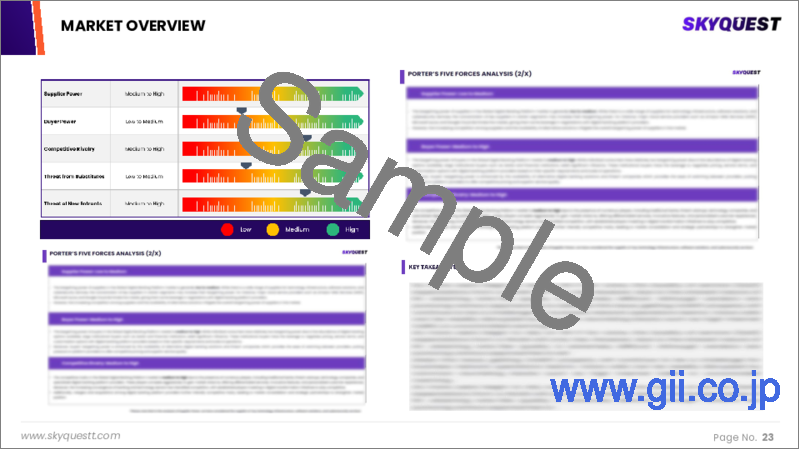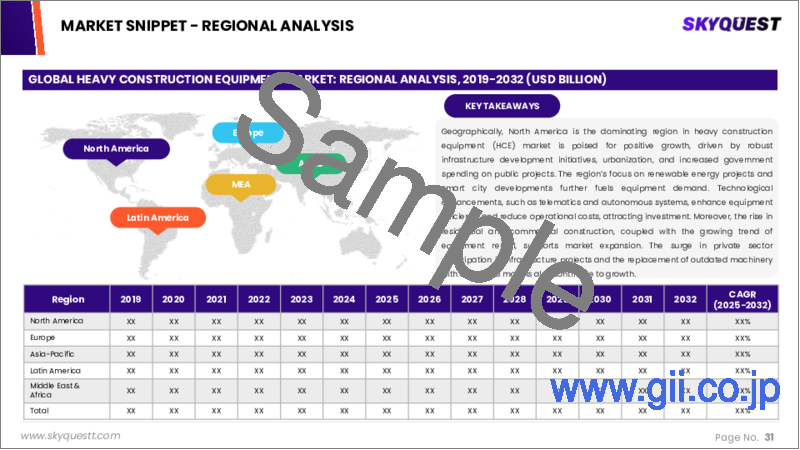|
|
市場調査レポート
商品コード
1603255
重建設機械の市場規模、シェア、成長分析、機器タイプ別、用途別、推進タイプ別、エンジン容量別、動力別、地域別 - 産業予測、2024年~2031年Heavy Construction Equipment Market Size, Share, Growth Analysis, By Equipment Type, By Application, By Propulsion Type, By Engine Capacity, By Power, By Region - Industry Forecast 2024-2031 |
||||||
|
|||||||
| 重建設機械の市場規模、シェア、成長分析、機器タイプ別、用途別、推進タイプ別、エンジン容量別、動力別、地域別 - 産業予測、2024年~2031年 |
|
出版日: 2024年11月26日
発行: SkyQuest
ページ情報: 英文 242 Pages
納期: 3~5営業日
|
全表示
- 概要
- 目次
重建設機械の世界市場規模は、2022年に1,903億米ドルと評価され、2023年の1,994億3,000万米ドルから2031年には2,902億米ドルに成長し、予測期間中(2024-2031年)のCAGRは4.8%で成長する見通しです。
建設機械の市場環境は、建設活動の急増と都市化とインフラ投資への関心の高まりによって、特に新興国で著しい成長を遂げています。市場の拡大が予想される背景には、世界中で施設のアップグレードを目指す政府の取り組みや、非住宅建設に対する民間部門の支出の顕著な増加があります。しかし、景気後退や機器の使用を規制する厳しい規制によって、市場の収益性が問われる可能性もあります。重建設機械は、特に大規模なプロジェクトにおいて、生産性を高め、タイムリーなプロジェクト完了を保証することで、プロジェクトコストの削減に極めて重要な役割を果たしています。特に熟練労働者が不足している状況では、購入よりもリースの方が費用対効果が高いことが証明されたため、建設重機をレンタルする傾向が引き続き強まっています。その結果、これらの先進的な機械は、日進月歩の建設業界において生産性レベルを維持するために不可欠なものとなっています。こうした力学は、今後の建設機械市場を形成するインフラ整備、市場動向、経済要因の複雑な関係を理解することの重要性を強調しています。
目次
イントロダクション
- 調査の目的
- 調査範囲
- 定義
調査手法
- 情報調達
- 二次データと一次データの方法
- 市場規模予測
- 市場の前提条件と制限
エグゼクティブサマリー
- 世界市場の見通し
- 供給と需要の動向分析
- セグメント別機会分析
市場力学と見通し
- 市場概要
- 市場規模
- 市場力学
- 促進要因と機会
- 抑制要因と課題
- ポーター分析と影響
- 競争企業間の敵対関係
- 代替品の脅威
- 買い手の交渉力
- 新規参入業者の脅威
- 供給企業の交渉力
主な市場の考察
- 重要成功要因
- 競合の程度
- 主な投資機会
- 市場エコシステム
- 技術の進歩
- 規制情勢
- 特許分析
- バリューチェーン分析
- ケーススタディ分析
- 顧客と購買基準の分析
- PESTEL分析
- マクロ経済指標
- 市場の魅力指数
- 価格分析
重建設機械の市場規模:機器タイプ別
- 市場概要
- 土木機械
- 掘削機
- ローダー
- バックホーローダー
- モーターグレーダー
- マテリアルハンドリング機器
- クレーン
- タワークレーン
- 移動式クレーン
- クローラクレーン
- フォークリフト
- コンベア
- ホイスト
- 大型建設車両
- ダンプトラック
- チップ
- トレーラー
- その他の機器
- 圧縮機
- 舗装材
- コンクリートミキサー
- ロードローラー
- 石破砕機
重建設機械の市場規模:用途別
- 市場概要
- インフラストラクチャー
- 道路
- 橋梁
- 鉄道
- ポート
- 建設
- 住宅用
- 商業用
- 鉱業
- 露天採掘
- 地下採掘
- 林業と農業
- ログ記録
- 土地開発
重建設機械の市場規模:推進タイプ別
- 市場概要
- ディーゼル
- CNG/LNG/RNG
- 電気
重建設機械の市場規模:エンジン容量別
- 市場概要
- 5L未満
- 5-10L
- 10L超
重建設機械の市場規模:動力別
- 市場概要
- 100HP未満
- 100~200HP
- 200HP以上
重建設機械市場規模:地域別
- 北米
- 米国
- カナダ
- 欧州
- 英国
- ドイツ
- スペイン
- フランス
- イタリア
- その他欧州地域
- アジア太平洋
- 中国
- インド
- 日本
- 韓国
- その他アジア太平洋地域
- ラテンアメリカ
- ブラジル
- その他ラテンアメリカ地域
- 中東およびアフリカ
- GCC諸国
- 南アフリカ
- その他中東・アフリカ
競合情報
- 上位5社の比較
- 主要企業の市場ポジショニング(2023年)
- 主な市場企業が採用した戦略
- 市場の最近の動向
- 企業の市場シェア分析(2023年)
- 主要企業の企業プロファイル
- 会社概要
- 製品ポートフォリオ分析
- セグメント別シェア分析
- 収益の前年比比較(2021-2023)
主要企業プロファイル
- Caterpillar Inc.
- Komatsu Ltd.
- XCMG Group
- Sany Heavy Industry Co., Ltd.
- Volvo Construction Equipment
- Hitachi Construction Machinery Co., Ltd.
- John Deere
- Liebherr Group
- Doosan Infracore
- Zoomlion Heavy Industry Science & Technology Co., Ltd.
- Terex Corporation
- JCB
- Hyundai Construction Equipment Co., Ltd.
- CNH Industrial N.V.
- Kobelco Construction Machinery Co., Ltd.
- Kubota Corporation
- Manitou Group
- Tadano Ltd.
- Sumitomo Heavy Industries, Ltd.
- Astec Industries, Inc.
結論と推奨事項
Global Heavy Construction Equipment Market size was valued at USD 190.3 billion in 2022 and is poised to grow from USD 199.43 billion in 2023 to USD 290.20 billion by 2031, growing at a CAGR of 4.8% during the forecast period (2024-2031).
The market landscape for construction equipment is witnessing significant growth, particularly in developing countries, driven by a surge in construction activities and a heightened focus on urbanization and infrastructure investment. The anticipated market expansion is further fueled by government initiatives aimed at facility upgrades worldwide and a notable rise in private sector spending on non-residential construction. However, the market's profitability may be challenged by economic downturns and stringent regulations governing equipment usage. Notably, heavy construction equipment plays a pivotal role in reducing project costs by enhancing output and ensuring timely project completion, especially for large-scale contracts. The trend toward renting heavy construction machinery continues to gain traction, as leasing proves to be more cost-effective than purchasing, particularly in contexts where skilled labor is scarce. As a result, these advanced machines are essential in maintaining productivity levels in the fast-evolving construction industry. Such dynamics underscore the importance of understanding the intricate relationship between infrastructural development, market trends, and economic factors that shape the construction equipment market moving forward.
Top-down and bottom-up approaches were used to estimate and validate the size of the Global Heavy Construction Equipment market and to estimate the size of various other dependent submarkets. The research methodology used to estimate the market size includes the following details: The key players in the market were identified through secondary research, and their market shares in the respective regions were determined through primary and secondary research. This entire procedure includes the study of the annual and financial reports of the top market players and extensive interviews for key insights from industry leaders such as CEOs, VPs, directors, and marketing executives. All percentage shares split, and breakdowns were determined using secondary sources and verified through Primary sources. All possible parameters that affect the markets covered in this research study have been accounted for, viewed in extensive detail, verified through primary research, and analyzed to get the final quantitative and qualitative data.
Global Heavy Construction Equipment Market Segmental Analysis
Global Heavy Construction Equipment Market is segmented by Equipment Type, Application, Propulsion Type, Engine Capacity and Region. Based on Equipment type, the market is segmented into earthmoving equipment, material handling equipment, heavy construction vehicles and other equipment. Based on Application, the market is segmented into infrastructure, construction, mining and forestry & agriculture. Based on Propulsion type, the market is segmented into diesel, CNG/LNG/RNG and electric. Based on power, the market is segmented into below 100 HP, 100-200 HP and above 200 HP. Based on Engine Capacity, the market is segmented into <5L, 5-10L, >10L. Based on Region, the market is segmented into North America, Europe, Asia Pacific, Latin America and Middle East & and Africa.
Driver of the Global Heavy Construction Equipment Market
The Global Heavy Construction Equipment market is being propelled by a growing demand for advanced construction methodologies and equipment. Customers worldwide are seeking technologically sophisticated and fuel-efficient machinery, which not only decreases labor costs but also improves task tracking throughout various stages of construction. This modern equipment contributes to lower operational expenses, enhancing overall efficiency. Market players are striving to broaden their market presence by introducing innovative products, services, and solutions that harness the power of information and communication technology (ICT) alongside the internet of things (IoT), which further drives the evolution of construction practices across the globe.
Restraints in the Global Heavy Construction Equipment Market
The global heavy construction equipment market faces significant restraints, primarily due to its adverse environmental effects. The operation of such machinery contributes substantially to poor air quality, serving as a major source of ozone emissions. These emissions, along with nitrogen oxides, volatile organic compounds, and carbon monoxide, disrupt the ecological balance in both urban and rural environments. Furthermore, mining equipment, often utilized in extraction activities, adds to the already considerable ozone emission levels. As concerns over environmental sustainability increase, the negative impact of heavy construction equipment on air quality and ecosystems poses a challenge for market growth and regulatory compliance.
Market Trends of the Global Heavy Construction Equipment Market
The global heavy construction equipment market is witnessing a significant upswing, driven by robust growth in the construction sector. The need for heavy machinery, including cranes for lifting and demolition equipment for waste management, is continually expanding. Technological advancements, particularly the integration of machine learning (ML) and the Internet of Things (IoT), are enhancing operational efficiency and equipment utilization through innovations like real-time data tracking and driver assistance systems. Additionally, rising demand for advanced construction technologies and supportive government initiatives for infrastructure development contribute to favorable market dynamics, positioning the sector for ongoing growth in the foreseeable future.
Table of Contents
Introduction
- Objectives of the Study
- Scope of the Report
- Definitions
Research Methodology
- Information Procurement
- Secondary & Primary Data Methods
- Market Size Estimation
- Market Assumptions & Limitations
Executive Summary
- Global Market Outlook
- Supply & Demand Trend Analysis
- Segmental Opportunity Analysis
Market Dynamics & Outlook
- Market Overview
- Market Size
- Market Dynamics
- Driver & Opportunities
- Restraints & Challenges
- Porters Analysis & Impact
- Competitive rivalry
- Threat of substitute
- Bargaining power of buyers
- Threat of new entrants
- Bargaining power of suppliers
Key Market Insights
- Key Success Factors
- Degree of Competition
- Top Investment Pockets
- Market Ecosystem
- Technological Advancement
- Regulatory Landscape
- Patent Analysis
- Value Chain Analysis
- Case Study Analysis
- Customer & Buying Criteria Analysis
- PESTEL Analysis
- Macro-Economic Indicators
- Market Attractiveness Index
- Pricing Analysis
Heavy Construction Equipment Market Size by Equipment Type & CAGR (2024-2031)
- Market Overview
- Earthmoving Equipment
- Excavators
- Loaders
- Backhoe Loaders
- Motor Graders
- Material Handling Equipment
- Cranes
- Tower Cranes
- Mobile Cranes
- Crawler Cranes
- Forklifts
- Conveyors
- Hoists
- Heavy Construction Vehicles
- Dump Trucks
- Tippers
- Trailers
- Other Equipment
- Compactors
- Pavers
- Concrete Mixers
- Road Rollers
- Stone Crushers
Heavy Construction Equipment Market Size by Application & CAGR (2024-2031)
- Market Overview
- Infrastructure
- Roads
- Bridges
- Railways
- Ports
- Construction
- Residential
- Commercial
- Mining
- Surface Mining
- Underground Mining
- Forestry & Agriculture
- Logging
- Land Clearing
Heavy Construction Equipment Market Size by Propulsion Type & CAGR (2024-2031)
- Market Overview
- Diesel
- CNG/LNG/RNG
- Electric
Heavy Construction Equipment Market Size by Engine Capacity & CAGR (2024-2031)
- Market Overview
- <5L
- 5-10L
- >10L
Heavy Construction Equipment Market Size by Power & CAGR (2024-2031)
- Market Overview
- Below 100 HP
- 100-200 HP
- Above 200 HP
Heavy Construction Equipment Market Size & CAGR (2024-2031)
- North America, (Equipment Type, Application, Propulsion Type, Engine Capacity, Power)
- US
- Canada
- Europe, (Equipment Type, Application, Propulsion Type, Engine Capacity, Power)
- UK
- Germany
- Spain
- France
- Italy
- Rest of Europe
- Asia-Pacific, (Equipment Type, Application, Propulsion Type, Engine Capacity, Power)
- China
- India
- Japan
- South Korea
- Rest of Asia Pacific
- Latin America, (Equipment Type, Application, Propulsion Type, Engine Capacity, Power)
- Brazil
- Rest of Latin America
- Middle East & Africa, (Equipment Type, Application, Propulsion Type, Engine Capacity, Power)
- GCC Countries
- South Africa
- Rest of Middle East & Africa
Competitive Intelligence
- Top 5 Player Comparison
- Market Positioning of Key Players, 2023
- Strategies Adopted by Key Market Players
- Recent Developments in the Market
- Company Market Share Analysis, 2023
- Company Profiles of All Key Players
- Company Details
- Product Portfolio Analysis
- Company's Segmental Share Analysis
- Revenue Y-O-Y Comparison (2021-2023)
Key Company Profiles
- Caterpillar Inc.
- Company Overview
- Business Segment Overview
- Financial Updates
- Key Developments
- Komatsu Ltd.
- Company Overview
- Business Segment Overview
- Financial Updates
- Key Developments
- XCMG Group
- Company Overview
- Business Segment Overview
- Financial Updates
- Key Developments
- Sany Heavy Industry Co., Ltd.
- Company Overview
- Business Segment Overview
- Financial Updates
- Key Developments
- Volvo Construction Equipment
- Company Overview
- Business Segment Overview
- Financial Updates
- Key Developments
- Hitachi Construction Machinery Co., Ltd.
- Company Overview
- Business Segment Overview
- Financial Updates
- Key Developments
- John Deere
- Company Overview
- Business Segment Overview
- Financial Updates
- Key Developments
- Liebherr Group
- Company Overview
- Business Segment Overview
- Financial Updates
- Key Developments
- Doosan Infracore
- Company Overview
- Business Segment Overview
- Financial Updates
- Key Developments
- Zoomlion Heavy Industry Science & Technology Co., Ltd.
- Company Overview
- Business Segment Overview
- Financial Updates
- Key Developments
- Terex Corporation
- Company Overview
- Business Segment Overview
- Financial Updates
- Key Developments
- JCB
- Company Overview
- Business Segment Overview
- Financial Updates
- Key Developments
- Hyundai Construction Equipment Co., Ltd.
- Company Overview
- Business Segment Overview
- Financial Updates
- Key Developments
- CNH Industrial N.V.
- Company Overview
- Business Segment Overview
- Financial Updates
- Key Developments
- Kobelco Construction Machinery Co., Ltd.
- Company Overview
- Business Segment Overview
- Financial Updates
- Key Developments
- Kubota Corporation
- Company Overview
- Business Segment Overview
- Financial Updates
- Key Developments
- Manitou Group
- Company Overview
- Business Segment Overview
- Financial Updates
- Key Developments
- Tadano Ltd.
- Company Overview
- Business Segment Overview
- Financial Updates
- Key Developments
- Sumitomo Heavy Industries, Ltd.
- Company Overview
- Business Segment Overview
- Financial Updates
- Key Developments
- Astec Industries, Inc.
- Company Overview
- Business Segment Overview
- Financial Updates
- Key Developments






